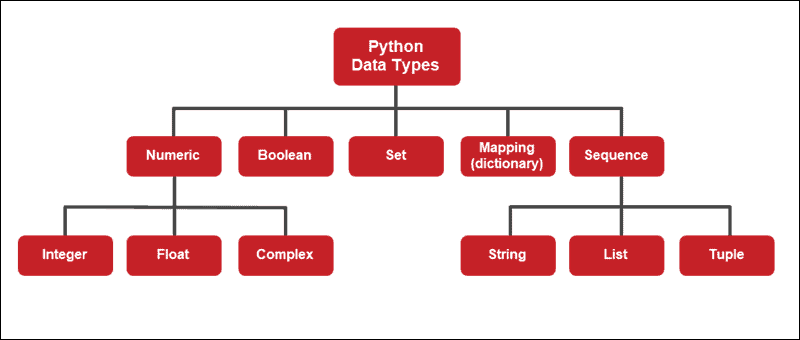Data Types:
In Python, data types are fundamental categories used to classify different types of data that variables can hold. Python is a dynamically-typed language, which means that you don't need to explicitly declare the data type of a variable. Instead, Python infers the data type based on the value assigned to the variable. Here are some of the common data types in Python:
Numeric Types:
int: Integer data type for whole numbers. Example:
x = 10.float: Floating-point data type for numbers with decimal points. Example:
y = 3.14.complex: Complex number data type with a real and an imaginary part. Example:
z = 2 + 3j.
Text Type:
- str: String data type for sequences of characters, enclosed in single or double quotes. Example:
name = "John".
- str: String data type for sequences of characters, enclosed in single or double quotes. Example:
Boolean Type:
- bool: Boolean data type representing True or False values. Example:
is_active = True.
- bool: Boolean data type representing True or False values. Example:
Sequence Types:
list: A mutable ordered collection that can hold elements of different data types. Example:
my_list = [1, 2, "hello"].tuple: An immutable ordered collection. Once created, its elements cannot be changed. Example:
my_tuple = (10, 20, 30).
Set Types:
set: An unordered collection of unique elements. Example:
my_set = {1, 2, 3}.frozenset: An immutable set. Once created, its elements cannot be changed. Example:
frozen_set = frozenset({4, 5, 6}).
Mapping Type:
- dict: A collection of key-value pairs, where keys are unique. Example:
my_dict = {"name": "Alice", "age": 25}.
- dict: A collection of key-value pairs, where keys are unique. Example:
NoneType:
- None: A special data type representing the absence of a value, similar to null in other languages. Example:
my_variable = None.
- None: A special data type representing the absence of a value, similar to null in other languages. Example:

Data Structures:
Data structures are fundamental constructs used to organize and store data in a way that facilitates efficient data manipulation and retrieval. They provide a way to represent and manage data effectively, making it easier to perform various operations and algorithms.
📚 Array:
📁 Collection of elements stored in contiguous memory locations.
📌 Elements accessed by index for quick retrieval.
⚖️ Constant time access, but may require resizing for changes.
🔗 Linked List:
🚄 Linear collection of nodes, each containing data and a reference to the next node.
➡️ Efficient insertions and deletions.
🕰️ Linear time access to elements.
📚 Stack:
📥 Last-in, first-out (LIFO) data structure.
➡️ "Push" elements onto the top, "pop" elements from the top.
📞 Used for function calls, undo mechanisms.
🚶 Queue:
🚶 First-in, first-out (FIFO) data structure.
➡️ "Enqueue" elements at the rear, "dequeue" elements from the front.
🗓️ Used for task scheduling, BFS algorithms.
Tasks:
Give the Difference between List, Tuple and set.
List:
A List is a mutable (modifiable) ordered collection of elements in Python.
It is defined using square brackets [] and elements are separated by commas.
Elements in a List can be changed, added, or removed after creation.
Lists allow duplicate elements, and their order is preserved.
Tuple:
A Tuple is an immutable (unchangeable) ordered collection of elements in Python.
It is defined using parentheses () and elements are separated by commas.
Once a Tuple is created, its elements cannot be modified, added, or removed.
Tuples allow duplicate elements, and their order is preserved.
Set:
A Set is a mutable (modifiable) unordered collection of unique elements in Python.
It is defined using curly braces {} or the
set()function and elements are separated by commas.Sets automatically remove duplicate elements, and their order is not guaranteed.
